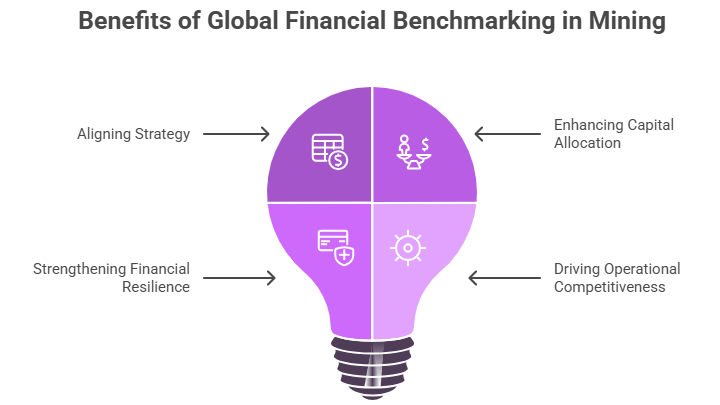The global mining industry is undergoing a paradigm shift from a production-centric model to one focused on financial resilience, operational agility, and sustainable growth. With rising capital costs, commodity price volatility, and stricter ESG standards, mining companies are realizing that operational performance alone is not enough. What differentiates market leaders today is the ability to deploy capital efficiently, generate stable returns, and plan strategically through uncertainty.
Traditional strategic planning in mining has largely relied on forecasting commodity cycles and project expansions, but this approach often overlooks financial variance across global peers. As new entrants disrupt cost structures and sustainability benchmarks evolve, mining enterprises must realign their long-term strategies with measurable financial insights.
This is where Global Competitiveness Financial Benchmarking becomes transformative. By comparing EBITDA margins, CapEx intensity, working capital efficiency, and ROCE across international players, Nexdigm helps mining organizations recalibrate their strategic planning frameworks to enhance profitability, investment readiness, and shareholder confidence.
Why Global Financial Benchmarking Is Essential for Strategic Planning in Mining
Strategic planning in the mining industry has traditionally been driven by production forecasts, resource estimates, and commodity outlooks. However, in today’s globally competitive environment, financial benchmarking has become an equally critical pillar of strategic decision-making. It helps leaders assess not only how much they produce, but how efficiently and profitably that production translates into sustainable value.

- Aligning Strategy With Global Financial Performance: Benchmarking allows companies to assess their financial position against global peers, measuring metrics such as EBITDA per ton, CapEx-to-revenue ratio, and free cash flow yield. These comparisons reveal whether a company’s cost base, investment intensity, and profitability align with global leaders, offering data-backed guidance to reshape corporate strategy.
- Enhancing Capital Allocation Discipline: Mining enterprises often face complex trade-offs between exploration, expansion, and modernization. Benchmarking provides visibility into ROCE, payback periods, and CapEx productivity, helping CFOs and strategy teams allocate funds toward projects that maximize returns and mitigate risk exposure.
- Strengthening Long-Term Financial Resilience: Commodity cycles are inherently unpredictable. Through financial benchmarking, organizations can evaluate cash flow stability, leverage levels, and margin volatility relative to industry benchmarks, allowing them to plan for sustained profitability even during market downturns.
- Driving Operational and Cost Competitiveness: Benchmarking highlights cost variances in areas like energy usage, logistics, maintenance, and labor efficiency, enabling companies to identify hidden inefficiencies and recalibrate operational models for improved financial output.
Nexdigm’s Global Competitiveness Financial Benchmarking Framework
At Nexdigm, we believe that effective strategic planning in mining begins with financial visibility and global comparability. Our Global Competitiveness Financial Benchmarking Framework enables mining companies to measure their performance against peers worldwide, helping them understand where they stand, what drives their profitability, and how to recalibrate long-term strategies with data-backed insights.
Stage 1: Peer and Market Mapping
We begin by identifying peer groups across commodities (iron ore, copper, gold, lithium, coal, and rare earths) and geographies, classifying companies based on scale, ownership structure, and capital intensity. This ensures the benchmarking exercise reflects the organization’s true competitive environment.
Stage 2: Financial KPI Benchmarking
Nexdigm benchmarks critical performance indicators such as EBITDA margin, CapEx intensity, ROCE, working capital efficiency, and leverage ratios. These insights reveal how efficiently the company converts capital into returns, compared to both regional and global leaders.
Stage 3: Strategic Gap and Efficiency Analysis
We analyze key financial variances to identify cost hotspots, underperforming assets, and capital inefficiencies. This allows leadership to understand which mines, operations, or projects are driving value and which require strategic intervention or restructuring.
Stage 4: Scenario Planning and Investment Modeling
Through advanced simulation models, Nexdigm helps leadership test multiple strategic scenarios such as expansion plans, commodity price fluctuations, or cost restructuring initiatives and assess their potential impact on margins, returns, and long-term sustainability.
Stage 5: Strategic Dashboard and Competitive Insights
All findings are compiled in a Mining Competitiveness Benchmarking Dashboard, giving executives a 360° view of their financial positioning and strategic levers. Nexdigm’s experts then deliver actionable insights to support capital reallocation, operational improvements, and future-ready strategy formulation.
Nexdigm’s benchmarking framework transforms static financial data into strategic foresight, enabling mining enterprises to evolve from reactive cycle management to proactive, performance-driven planning.
To take the next step, simply visit our Request a Consultation page and share your requirements with us.
Harsh Mittal
+91-8422857704

